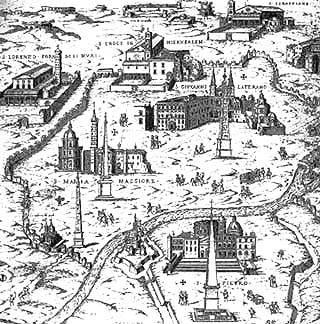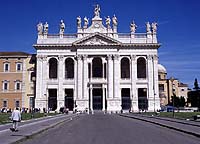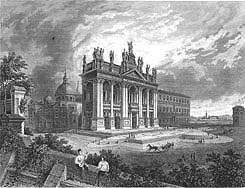The Three Great Basilicas
 |
St. Giovanni in Laterano
 Officially "Mater et Caput”, Mother and Head of all the churches in the city and the world. For Catholics the next most important MUST Basilica after St. Peter's.
Officially "Mater et Caput”, Mother and Head of all the churches in the city and the world. For Catholics the next most important MUST Basilica after St. Peter's.
Facade. (1691 - 1736 A. Galilei). The 15 Baroque statues of Christ and the Saints over the main entrance are so large they are out of proportion with the old Basilica. They are beacons visible from far away, showing the might and strength of the Church. Contemporary wags said they would crush the facade and church.
The central bronze doors (1C BC), faded green beauties with stars, are the originals from the ancient Senate Building (Curia) in the Roman Forum.
The little doors on the far right with a bronze cross closing them, are only opened in Holy Years.
Colossal marble statue of Constantine (4C AD) used to adorn the Imperial Baths on the Quirinal hill.
Nave. Gigantic statues of the Apostles (17C). In gray marble, they dwarf most of the rest of the decoration.
Ceiling. Original design by students of Michelangelo. Ornate and colorful, it shows the coats of arms of Pius IV (1562).
Floor. Superb 13C mosaic floor originally laid by Vassalletto and his son, cleaned and relaid in the 16C.
Corsini Chapel. On left. Ornate wrought iron doors are usually closed, but inside is a red porphyry tomb of Clement XII, from the Pantheon, and fragments of Giotto's fresco depicting Bonifacio VIII heralding the first Jubilee Year: 1300.
Massimo Chapel. On right. A reproduction of Pope John Paul II's favorite painting, the black Virgin of Czestochowa, was installed the year of his election, 1978.
The Baldacchino Altar. (14C). The Pope is the only prelate who can officiate at this altar. Visible in its top story are reliquaries of two superb sculpted heads. Inside them are the skulls of St. Peter and St. Paul. Under the altar table are bits of wooden planks: fragments of the first altar of the Popes (4C).
Confessio. (9C). Looking down an open crypt one sees the tomb of Pope Martin V (1417-31). Circa 1440 Donatello's brother carved the statue.
Apse. This is part of Constantine's Basilica. The Papal Throne looks rather small and insignificant, with gold mosaics glittering behind it. On the wall high above mosaics from the 5C and 13C (Jacopo Torriti) were reworked in the 18C.
The Cloisters. (13C). Vassalletto and his son were busy here too, but so many of the miniature mosaics which should have given sparkle and luster to the curly columns have been picked out and destroyed (armies of soldiers or tourists?) that the columns now are just a lesson in how they were made, rather than a pleasure for the eyes.
Not to be missed for the salacious history buff, the supposed “Chaise Percee” or “Sedia Stercoidale”, from beneath which (according to the custodian) it was determined whether the aspirant Pope was really a man. We doubt that this tiny hole was used for such purposes.
Porch on North. A giant Henri IV of France, in bronze, shows him dressed in Roman gear swashing around with a sword. He had given many gifts to the Lateran.
Baptistery. (4C). Built by Constantine, this octagonal hall baptized everybody in the 4C. Rebuilt in the 5C by Sixtus III who added the beautiful “salami” (porphyry) columns. Frescoes were added by Pope Urban VIII in 1637.
The four chapels date back to antiquity. The chapels of St. John the Baptist and St. John the Evangelist were built by Pope Hillary (461-468). The ancient door is a mix of silver, gold and bronze. The Chapel of St. Venantius is 7C; and that of Saints Rufina and Secunda is 12C; but here the apse has 5C mosaics.
Lateran Palace. (1586). Architect Domenico Fontana built this magnificent home for Pope Sixtus V. Now used as offices for the Rome City Vicariate.
Triclinium of Leo III. The Roman style dining room of the medieval Pope has been reconstructed. The mosaic, extensively repaired in the 18C, celebrates the Pope honoring Charlemagne.
|
St. Giovanni in Laterano and the Lateran Palace
History 
60 AD circa. Nero expropriated this vast property from the Laterani family. 161. Emperor Marcus Aurelius built a palace on the other side of the square, under part of the present-day hospital. 226 circa. Emperor Septimius Severus returned the land to the Laterani. 305-312. Emperor Maxentius' elite bodyguards were housed here, under the present Basilica. 312. Constantine, one of the two Emperors of a then divided empire, married to Fausta, sister of Maxentius, destroyed his brother-in-law's armies and killed him to boot! Constantine thus became sole ruler of a reunited empire. He ordered the basilica and baptistery built here. (What better way of erasing Maxentius' memory than to destroy his soldiers' barracks). 313. Fausta turned over her house on this property to Pope Melchiades for a council of bishops. (Thirteen years later Constantine had her killed in her bath). 5C. In the Dark Ages Barbarian invasions damaged the Lateran complex. It was the prime target for marauding armies since the Pope ruled from here (the Vatican didn't exist). 896. An earthquake damaged the buildings. Maybe God was punishing Pope Stephen VI for the macabre trial in which he accused his predecessor's corpse, dressed in vestments, of making a treaty with the Barbarian King. Found guilty, the corpse was thrown in the Tiber. Pope Stephen was soon imprisoned and strangled for his wicked ways. 12C, 13C and 16C. Councils of Lateran were held - high churchmen made important ecclesiastical decisions (even excommunicating rebellious kings). 1309-77. Papacy sequestered in Avignon. When the Popes returned they found the Lateran in such bleak condition that they switched to the Vatican. 1929. The last Council of Lateran defined the Church's temporal possessions, largely confined to Vatican City, which became the Holy See. Mussolini signed the “Lateran Treaty” with the Church, finally ending its state of war which had existed since the reunification of Italy. (For six decades the Popes had lived as self-imposed “Prisoners of the Vatican”). |
Obelisk
(Obelisco). Egyptian. Tallest one in Rome (15C BC).
| Obelisk History 15C BC. This pink granite obelisk stood in front of a temple in Thebes, Southern Egypt. 357 AD. The Romans stole it and placed it on the central “spina” of Circus Maximus. 1568. Discovered buried and broken; erected here by Pope Sixtus V's architect Domenico Fontana. |
Scala Santa
Sixtus V tore down (1585-90) the remnants of the enormous old palace, but kept the stairs - ostensibly from Pontius Pilate's palace in Jerusalem.
The devout climb up on their knees since Christ is said to have walked up these steps to face judgement. If you wish to walk, use the sides.
The little chapel at the top, “Sancta Sanctorum”, the Holy of Holies, is the Pope's chapel, always closed - yet one can get a glimpse of the lovely cosmatesque floors through a massive grill.
There are precious relics from Jerusalem there, protected by the Passionist fathers.